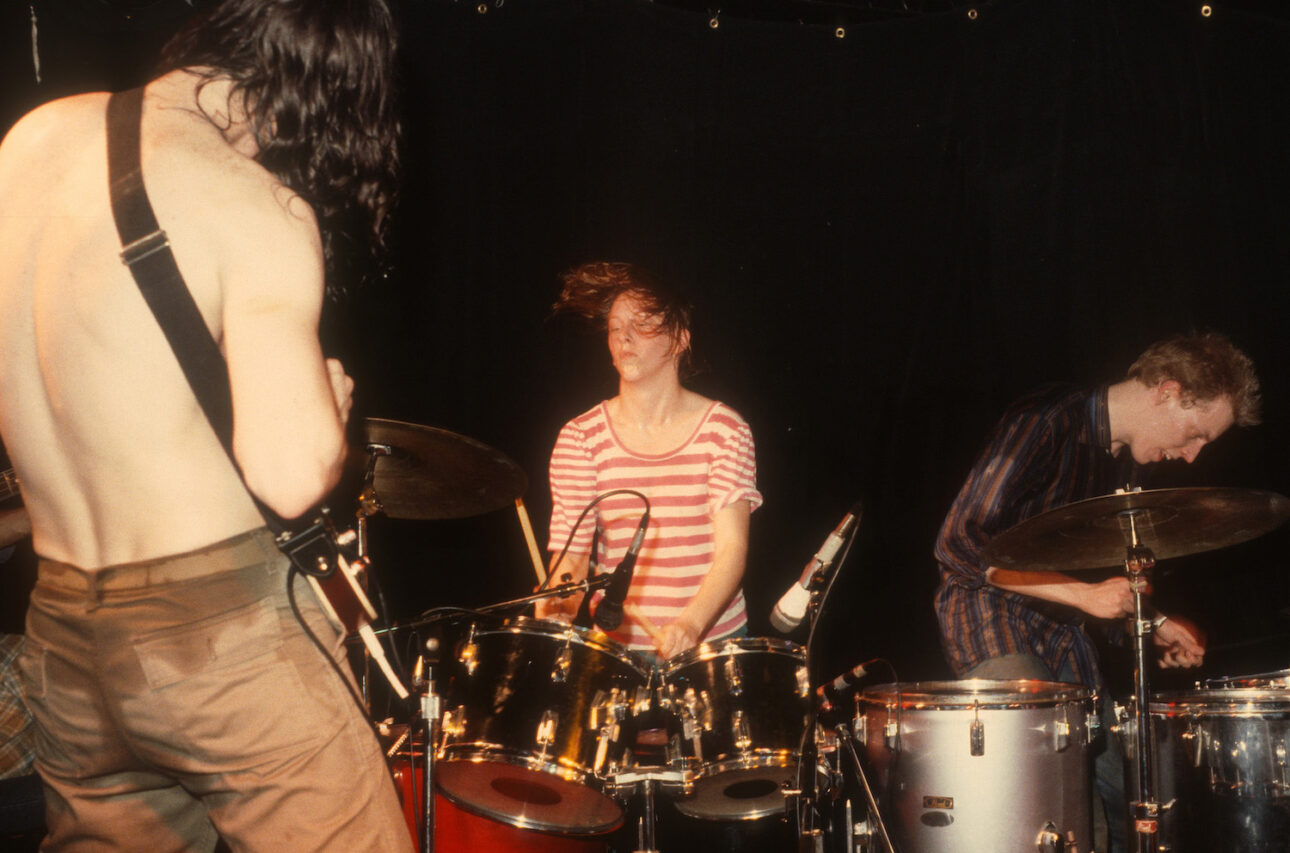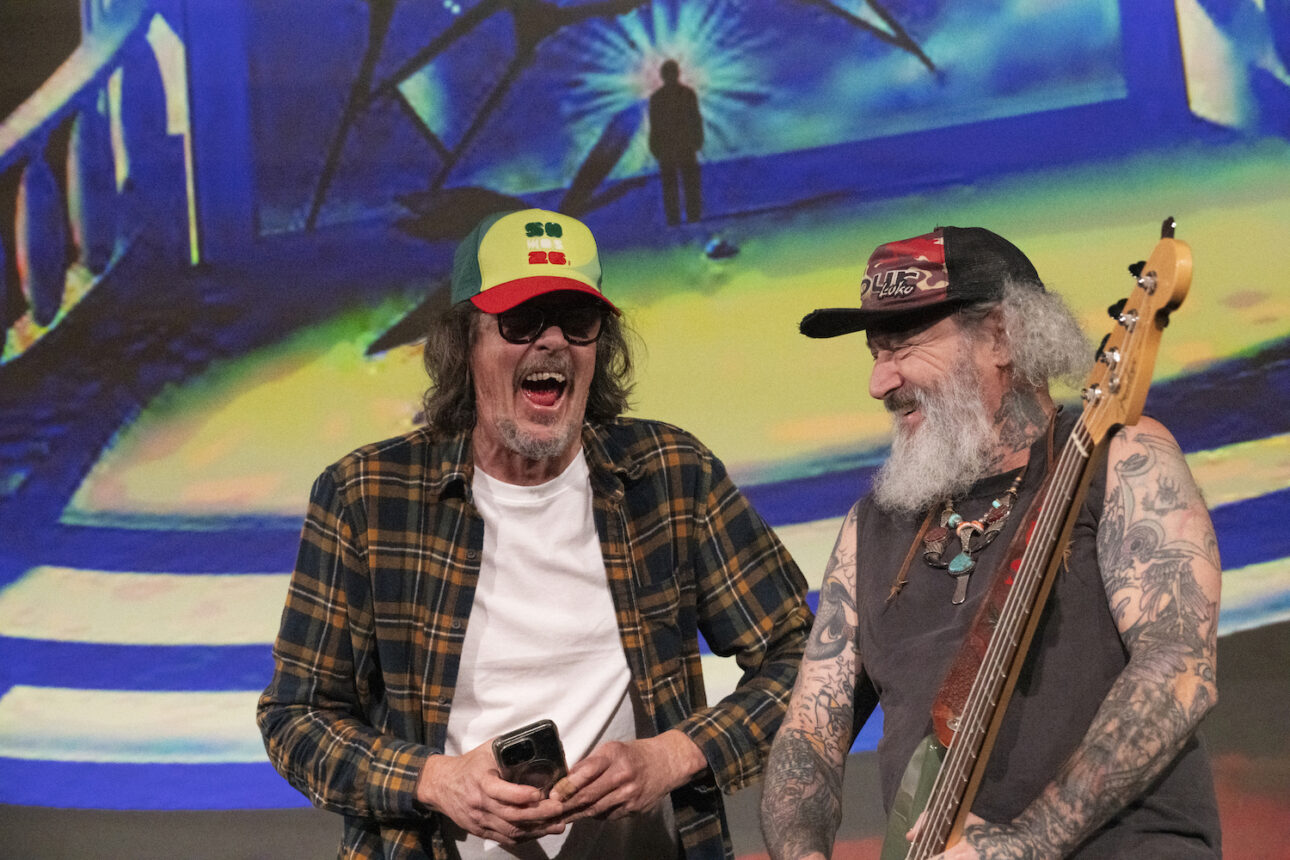Butthole Surfers: The Hole Truth and Nothing Butt, Tom Stern’s bio-doc chronicling the chaotic yet culturally significant career of San Antonio, Texas’ Butthole Surfers, was much-lauded at South By Southwest earlier this year for its revelatory examination of the band—which lives up to its title with a humorous, heartfelt, and unflinchingly honest approach. It’s also a rollicking look at one of the most brilliant, experimental, and misunderstood collectives in music history.
The documentary made its West Coast debut September 23, kicking off Beyond Fest—the popular alternative genre movie series hosted by Neon and the American Cinemateque inside Hollywood’s Egyptian Theatre.
Friends, famous fans, and a multitude of bassists and drummers throughout Butthole Surfers’ trajectory are interviewed, but the spotlight is mostly on its founders, vocalist Gibby Haynes and guitarist Paul Leary. Their relationship started off as a creatively charged stoner bromance and ended up distanced, if not estranged, with both men recalling certain parts of their journey differently.
Of course, that’s mostly due to drug use. The band members were known not just for drinking and toking themselves silly while touring across the country in their early years, but for dropping LSD and mushrooms right before live performances, which made their sets unpredictable and often volatile.
These noisy freakouts became the stuff of underground legend, but their ground-breaking album releases on labels like Alternative Tentacles, Touch and Go, and Rough Trade in the ’80s, and later Capitol Records (where they scored a mainstream hit, “Pepper,” off of Electriclarryland in ’96) influenced the musical landscape for years to come.
The band has been due a proper cinematic biography and this one delivers in a fittingly frenetic way, highlighting both the madness of the past and reflective regrets of today.
After the Hollywood screening, Talking Heads’ Jerry Harrison conducted a Q&A, but it was clear that the band didn’t want to talk too much about the film, with Haynes going off on tangents about Tex Mex food and jokingly calling music docs in general “bullshit.” About three questions were asked and answered (sort of) when Haynes gestured toward a set-up behind them. Then Butthole Surfers played a surprise mini-set of three songs including “Cherub,” “1401,” and “The Shah Sleeps in Lee Harvey’s Grave.”

SPIN messaged the filmmaker afterward to ask about the challenges of documenting such a tempestuous crew. “A big advantage I had is that I knew from the outset I would just keep shooting until I thought I had enough no matter how many years that took,” Stern says. “Production line-style documentaries like the ones you see on Netflix have a limited timeframe to shoot in, so they either get the goods or they don’t on the first couple tries, but I interviewed Gibby at least 20 times over five years and ultimately got the emotional vulnerability I was hoping for. He’s such a complicated guy and I felt the audience would want to understand him on a deeper level than what you see in the typical rock doc.”
With hilarious puppet reenactments, wacky animation, awkward but illuminating edits, and outrageous archival footage, including the band’s infamous 1986 NYC Danceteria club show (which featured simulated sex on stage), The Hole Truth may not be a typical rock doc, but it is a highly entertaining one.
Everyone from Dave Grohl to Keith Morris share fond memories, recalling the rhythmic rituals of dueling drummers King Coffey and Teresa Taylor, Leary’s astounding psychedelic riffage, and Haynes arresting presence as he trampled the stage in a bloody dress or completely naked, with fire, strobe lights, and graphic medical films adding to the spectacle.
The doc has a massive roster of famous commentators, too. And while some of them question the band’s choices—both live and on record—all of them tout B.S.’s transcendence and talent. Eric Andre, Flea, Ian MacKaye, Steve Albini, Donita Sparks, Henry Rollins, Thurston Moore, Wayne Coyne, Ice-T, Al Jourgensen, Richard Linklater, John Paul Jones, and many more share their thoughts and recollections, but two appearances in particular stand out.

Johnny Depp (who befriended Haynes during the “Hollywood years” as it’s referred to in the doc) marks a low point, when the pair dabbled with heroin. He speaks somberly of the era, when he and Haynes formed a supergroup with the Red Hot Chili Pepper’s Flea and John Frusciante called P., which headlined Depp’s Sunset Strip club The Viper Room the night River Phoenix died there.
He’s followed up with Thelonious Monster’s Bob Forrest, now an addiction recovery advocate, reflecting on Haynes’ guilt over Phoenix’s passing and bad advice he gave Kurt Cobain before his death. Forrest also helps the frontman revisit suppressed memories of childhood sexual abuse, which may have led to his self-destructive tendencies.
Then we learn that Taylor, one of the most charismatic characters in the movie (she also starred in and became the poster girl for Linklater’s Gen-X classic Slackers after she left the band) was dying of lung disease and perished before it was completed, as did Coffey’s husband, who battled brain disease. Both figures are important reminders that the Surfers’ brought queer representation to the punk community (in Texas no less) before it was actually accepted. Their personal struggles are heart-wrenching and make for a pretty heavy last act.
But ultimately, The Hole Truth takes fans on a wild ride filled with lots of laughs, vivid visuals, and thoughtful perspectives. It’s an amalgamation that captures the irreverent spirit and visionary madness of the group itself.
“My goal was to cement a place in music history for this amazing band because they deserve it,” Stern shares. “They were singular artists, each one an amazing character, and they evoked such strong, emotional responses from audiences, including, obviously, me.”
→ Continue reading at Spin

